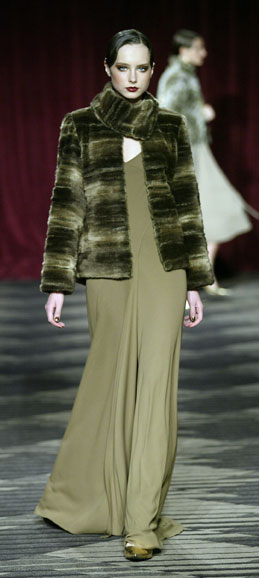March
2006
Designing
A Cruelty-free World
The Satya Interview with
Marc Bouwer
|
|
Photo courtesy of Marc
Bouwer |
|
Marc Bouwer’s
faux fur fashion. Photo courtesy of Marc Bouwer |
As a New Yorker whose fashion
sense is informed by thrift stores, stoop sales, and the occasional
message tee, I had no idea who Marc Bouwer was when we met at a cruelty-free fashion event in December. He was
a nice, unassuming fellow in worn jeans who served as a judge for the
HSUS “Cool vs. Cruel” competition to inspire young designers
to create fur-free designs. As first prize, the best designer won a
coveted internship at Marc Bouwer’s design studio. After doing
a little homework, I learned that Marc Bouwer is a major designer,
indeed. His elegant gowns are worn on red carpets by the likes of Halle
Berry, Angelina Jolie and Charlize Theron. Bouwer’s client list
also includes some of the most ubiquitous celebrities in the world,
like J. Lo, Paris Hilton and Jessica Simpson.
Marc Bouwer is one of only a handful of major designers who is publicly and unabashedly
committed to being fur-free. While many of his clients wear real fur, he is up
front about the fact that he does not use animal skins in any of his clothing.
As a fashion powerhouse, Bouwer is in a unique position and very well may have
played a deciding role in Mariah Carey’s recent decision to shun fur.
In addition to educating his clients, Bouwer is doing his part to have a positive
impact on the fashion world. As he puts it, “I want to help as much as
I can with any of the organizations who want to help protect animals.” He
hasn’t used fur or leather in his designs in well over a decade. In 2002,
Marc presented a completely animal product-free collection, which was sponsored
by PETA.
One of the most effective tactics that brought fur back into fashion with a vengeance
is the strategy to entice young designers into using fur in their collections.
Saga furs, the joint marketing group for the Scandinavian fur industry, flew
designers to Scandinavia on junkets to educate them about the different animal
pelts available, giving them free furs, and assisting them in integrating fur
into their designs. Marc Bouwer is actively engaging with young designers in
a different manner. In addition to his participation in the “Cool vs. Cruel” design
competition, Marc is a guest lecturer at FIT and Parson’s, the city’s
premiere design schools. This semester, he is challenging students to create
a collection “without any animal products in it at all: no cashmere, fur,
wool,” as he describes it.
A native of South Africa, Marc has rooted himself in a thriving center of the
fashion world: New York City. In the midst of preparations for fashion week and
red carpet events, Marc Bouwer took a moment to talk with Catherine
Clyne about
cruelty-free fashion and the fight against fur.
What first made you aware of the cruelty involved in fur?
I think any intelligent person, when you think about it, realizes there’s
death involved with this type of fashion. And you read about it and just become
aware of how savage this industry is. I don’t like that there’s death
involved in [fur] because it’s such a frivolous thing.
When I was a young designer, Saga [the Scandinavian fur industry group] gave
me a whole bunch of fur to use in one of my collections. And I thought, ‘Oh,
how beautiful, how fabulous! White fox—more, more, more!’ But then
as I became more aware of exactly what goes on; and as you mature as an individual
and become more of a caring person about your environment and the lives of helpless
individuals and animals, I think any decent, caring individual is not going to
want to be a part of that.
How have you incorporated your awareness of fur and cruelty into your designs?
I haven’t used fur in my collections for over 16 years. What I’m
trying to do is show people that there is an alternative. The technology has
advanced so incredibly that you’re able to get the look and feel of real
fur. And also leather—I haven’t used leather in my collection for
probably almost as long. With leather, even more so than fur, the technological
alternative is so apparent that you can’t even make an argument about it—the
look and feel is there. It’s more durable, it’s less expensive—well,
not always. It is a bit of a problem because animal skin and fur are treated
in such a throw-away manner in this industry that sometimes using rabbit fur
is cheaper than using faux fur. This is something that we have to work on. Of
course, there is high quality and poor quality fur, as well as high quality and
poor quality faux fur. So it’s just a choice.
A few weeks ago you said to me that if we can’t get people to care about
fur animals, it’s sort of a ‘losing battle.’ What do you think
are ways we can get people to care, both with the fashion-wearing public and
designers?
I think just constantly making them aware of the cruelty involved and how unnecessary
it is by showing them the alternatives provided by technology and making them
much more accessible than they are. Just a continuous bombardment with information.
It’s a slow process. A hundred years ago people also thought that black
people shouldn’t have the rights of white people. And 30 years ago people
thought that smoking was okay for you. It’s all a matter of becoming a
more advanced society and more caring individuals.
Am I wrong? Is fur still a really big deal in fashion? It seemed to go
out of
fashion for awhile and now it’s back—with a vengeance.
I know! I just got back from an appointment uptown. The weather was so nice,
I decided I’d walk down Fifth Avenue. The amount of furs that I saw on
people and the amount of fur trim—whether on men’s jackets or baubles
hanging from hats, to full-on fur coats—and myself as an expert in this
field, I can tell what is fake and what’s not, and the amount of real fur
out there is grotesquely shocking.
Why don’t you think many of your fellow designers ‘get it’ anymore?
What happened?
I think number one, there is the financial aspect to it. You know, I could have
gotten millions of dollars in fur licensing by now. I could be able to live a
much better lifestyle than I am living right now if I had taken these offers.
But I sleep in peace at night knowing that I’m not part of that. So that
makes me feel like I’m a somewhat better person than others, because I
don’t indulge in that kind of cruelty for such a frivolous end.
Then there’s also the ‘Well I don’t care about anything’ attitude
with a lot of people who are in fashion. They are all about themselves, and all
about the decoration of themselves and the fabulousness of that world, and it’s
all about acquisition, it’s about indulgence, and it’s about [sighs]
just acquiring more—more decoration and labels and whatever. A big problem
with the industry also is that a lot of people who buy this fashion think of
it as a status symbol. It’s just wrong and just shows how uneducated and
how uncaring people can be. To think that wearing more fur is a status symbol,
particularly in the music industry, I think they’re the worst!
[Laughter.] Yes, we all love Jennifer Lopez…
Mary J. Blige, Lil’ Kim. You know we got Mariah [Carey] to get rid of all
her fur—she’s totally against it and wearing only faux fur now. I’ve
had long conversations about this with Mariah and she’s so in our, how
can I put it, our court now, which is nice.
What do you feel are the most effective things animal activists can do to change
the use of fur in the fashion industry?
Public awareness. Education. And doing things like they did [with] J. Crew. I
think protesting without violence of course, because that’s exactly what
we’re trying to fight—the violence against animals. But strong, vocal
protests are always good, and pictures and information that’s handed out
to people. I mean, what else can one do?
Are you vegetarian?
You know, I am trying to become a vegetarian. I don’t eat any red meat
anymore—I cannot go near [it]. Though every now and then I have some chicken,
unfortunately. But having been brought up that way, it’s a battle. I think
if vegetarian food was more accessible—not for myself but for everybody—people
would find it easier to become vegetarian. But every time I eat chicken, I always
think about that I’m eating flesh. I know it’s a slow process, but
I think by the end of this year I will have completely cut it out.
What’s your opinion of using things that look so much like fur
that people
might get the wrong idea?
Well, that’s a whole other problem. Until people stop killing animals for
fur… You know, maybe [laughs] we just shouldn’t even be showing fur.
With the technology today the fur looks so real. So the one argument is, ‘Don’t
wear real fur because you can wear exactly the same thing without any death involved.’ But
then the problem is that you are then propagating the idea of fur by wearing
it. And a lot of people can’t tell what is real and what is not real.
The reason why I use faux fur in my collections is that so many of my clients
wear fur. So I’m trying to educate them to get away from the real fur so
at least they know they’re not buying the real thing but they can get the
look of it. And a lot of them have come along that way.
But it’s a problem. I don’t know what the answer is. But at least
if you can buy something that is cruelty-free, you can feel better about yourself.
To learn more about Marc Bouwer’s cruelty-free designs and see
a list of
his impressive clients, visit http://marcbouwer.com.
|
|
|
| © STEALTH TECHNOLOGIES INC. |
|


